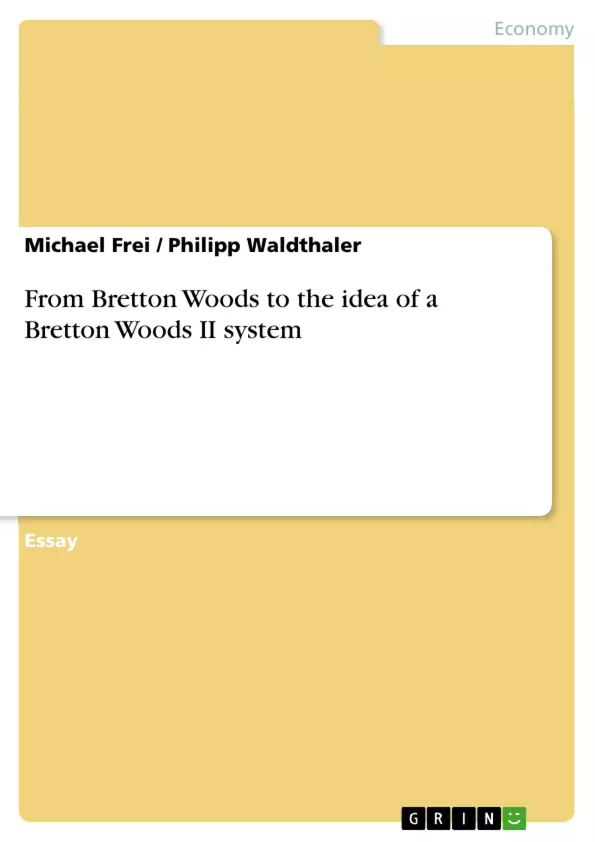The Bretton Woods institutions – International Monetary Fund (IMF) and International Bank for Reconstruction and Development (IBRD) = World Bank – are based on a hierarchical level of cooperating national states. The function of the International Monetary Fund is to be a reserve bank of industry states, as well as being a controlling body which is supervising the account of payments and the accounts of debits. The duties of World Bank have been defined to coordinate and resolve development and reconstruction aid. (Tetzlaff, S. 47).
It was a long way before the Bretton Woods institutions began their work concrete in 1947. From 1942 until the conference in 1944 in Bretton Woods were discussed proposals by different states. Many oft that proposals was presented by the United States and by Great Britain. Some of the fundamental aspects in the discussion presented by the national states were to build up a strong world economic, to influence the capital movement, to provent currency manipulation but also to maintain the national currency and economic policy.
Contents: Economic situation until the foundation of Bretton Woods in 1944, Bretton Woods – Theoretic idea, The End of the Bretton Woods System, The Bretton Woods II System in Asia, Euro or Dollar?, Conclusion
Inhaltsverzeichnis (Table of Contents)
- Economic situation until the foundation of Bretton Woods in 1944
- Bretton Woods - Theoretic idea.
- The International Monetary Fund (IMF).
- World Bank
- The End of the Bretton Woods System
- Floating versus fixes exchange rates._.
- The Bretton Woods II System in Asia _
- Euro or Dollar?
- Conclusion
Zielsetzung und Themenschwerpunkte (Objectives and Key Themes)
This paper examines the historical context and development of the Bretton Woods system, analyzing the economic situation leading up to its establishment, the theoretical ideas behind the system, and its eventual demise. It also explores the emergence of the Bretton Woods II system and the ongoing debate between the Euro and the Dollar as dominant currencies.
- The economic conditions preceding the Bretton Woods agreement
- The theoretical framework and objectives of the Bretton Woods system
- The breakdown of the Bretton Woods system and the transition to floating exchange rates
- The emergence of the Bretton Woods II system in Asia
- The debate on the future of international monetary order and the role of the Euro and Dollar
Zusammenfassung der Kapitel (Chapter Summaries)
- Economic situation until the foundation of Bretton Woods in 1944: This chapter explores the economic climate leading up to the Bretton Woods agreement, including the aftermath of the Great Depression and the impact of World War II. It analyzes the role of the United States and Great Britain in shaping the international economic order.
- Bretton Woods - Theoretic idea: This chapter examines the theoretical principles and objectives underlying the Bretton Woods system. It discusses the roles of the International Monetary Fund (IMF) and the World Bank, and the broader goals of international economic cooperation.
- The End of the Bretton Woods System: This chapter analyzes the factors that contributed to the breakdown of the Bretton Woods system, including the transition to floating exchange rates and the emergence of new economic challenges.
- The Bretton Woods II System in Asia: This chapter explores the emergence of a new economic order in Asia, characterized by regional cooperation and the rise of emerging economies.
Schlüsselwörter (Keywords)
The main keywords and focus topics of this paper include Bretton Woods, International Monetary Fund (IMF), World Bank, fixed exchange rates, floating exchange rates, economic cooperation, global economic order, international finance, Euro, Dollar, emerging economies, and Asian economic integration.
- Quote paper
- Michael Frei (Author), Philipp Waldthaler (Author), 2009, From Bretton Woods to the idea of a Bretton Woods II system, Munich, GRIN Verlag, https://www.grin.com/document/230775



